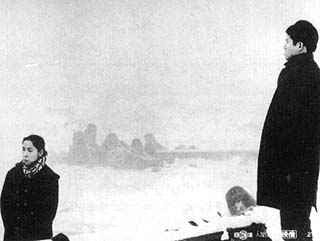A mystery without a solution, A Man Vanishes (1967) is a fascinating study of the eminently collapsible boundary between reality and artifice. More precisely, it suggests that what we think of as “reality,” and how we behave in this framework, is as much a construction as any work of fiction. Initially, the film seems to be an example of the cinema verité documentary style prevalent in the 1960s. A voiceover informs us that even on the “small island” of Japan, hundreds of people a year can easily vanish among the crowds of people, never to be seen again. The film is ostensibly a study of one of these “johatsu,” or missing persons. We focus in on the particular case of Tadashi Oshima, a man who disappeared one day on his way to work, and the efforts of his fiancée, Yoshie Hayakawa, to find him. The camerawork is handheld, and fly-on-the-wall observant. There is little music, and all indications point to the idea that this is a document of Yoshie’s search, with an “investigator,” actor Shigeru Tsuyuguchi (the rapist from Intentions of Murder), accompanying her to interview people who knew him in order to find out where he is and why he disappeared so suddenly.
However, there are signs that Imamura is up to something different here, beginning with the credits sequence, in which a medium attempts to contact Oshima. This is rather odd, since he is apparently still alive. “The unhappy spirit of a woman haunts him,” the medium says of Oshima, and this explains why he cannot love any woman. The medium reappears at other points in the film, sometimes as brief flashes.
The film delves into the investigation, revealing the many layers of personality and history that exist beneath the surface of this apparently ordinary salesman and the lives of those connected to him. Among other details, we learn that he had embezzled money from his company over a two-year period, and kept a mistress while he was away on business, who he may or may not have gotten pregnant. The animosity between Yoshie and her sister Sayo also surfaces in the course of this search. Yoshie disapproves of her sister’s relationship with a man she is not married to. She also comes to suspect that Sayo may have had an affair with Yoshie.
The verité veneer begins to drop away as we see how Imamura is manipulating certain actions, as he would in a drama. At one point, Yoshie confesses she is beginning to fall in love with Tsuyuguchi; he tells Imamura that this would be “awkward.” We see discussions between Imamura and his crew (in which Yoshie is frequently referred to as “The Rat”) in which they discuss how the film is going and where they want to take it.
The “documentary” aspect of A Man Vanishes, already questionable and extremely flimsy, completely collapses at the end of a long scene in which Yoshie, increasingly agitated, interrogates her sister about the fact that several people have reported seeing Sayo and Oshima together. They argue at either end of a dinner table, with Imamura sitting silently between them. A fishmonger is brought in, who confirms that he did indeed see the two of them together. Despite all this, Sayo strenuously insists that everyone who saw them together is mistaken. It is a lengthy and repetitious scene, with neither side willing to budge. Sayo then turns and asks Imamura, “Director, what is truth?” Imamura answers, “I don’t know what’s the truth. Nobody knows the truth.” At this point, the film’s most audacious and astonishing gambit occurs: Imamura yells to the crew, the walls fall away, and it is revealed that the scene we’ve just witnessed has been occurring on a soundstage. A narrator informs us that everything we have seen up to that point is fiction, although this fiction is indeed based on actual disappearances.
The camera crew moves to the street, and the argument resumes as a growing crowd gathers. Even though the scenario has been revealed to be fictional, the arguments on either side become increasingly passionate, resulting in an irreducible impasse. Both sides insist that their version of reality is the truth, and nothing is resolved. Imamura and Yoshie speak to each other in a voiceover at the film’s conclusion. “The film is finished, but reality is not,” Imamura says. A Man Vanishes is one of Imamura’s most idiosyncratic and unsettling films, in its radical fracturing and questioning of cinema’s representation of what appears in front of the camera.





